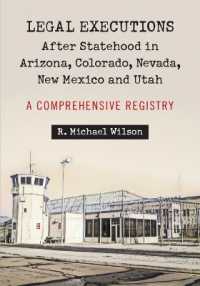- ホーム
- > 洋書
- > 英文書
- > Science / Mathematics
Full Description
Thorough review of how artificial intelligence can enhance the design, control, and optimization of power electronics systems
Artificial Intelligence for Power Electronics provides a comprehensive overview of the intersection between artificial intelligence (AI) and the field of power electronics, exploring how AI can revolutionize and enhance the design, control, and optimization of power electronics systems. The book covers the fundamentals of AI and power electronics, and the challenges the field faces in design to production, with the solutions of these challenges through AI methods. Example solutions, along with Q&A review sections, are included throughout the text, with coverage of both Python and MATLAB.
Some of the topics discussed in this book include:
Supervised, unsupervised, and reinforcement machine learning and the role of data in training machine learning models
Techniques for AI data collection in power electronics and how to clean, normalize, and handle missing values of data
Optimization techniques such as Particle Swarm Optimization and Ant Colony Optimization
Detection techniques for identifying faults and anomalies and clustering algorithms to group similar operational behavior
Essential Python libraries for machine learning and how to perform machine learning on a Raspberry Pi
Delivering an industry-specific approach to AI applications, Artificial Intelligence for Power Electronics is a helpful reference for undergraduate, postgraduate, and PhD students in electrical, electronic, and computer engineering. Mechanical engineers and other industry professionals may also find it valuable.
Contents
About the Editors xvii
List of Contributors xix
Preface xxi
1 Fundamentals of Power Electronics and Key Challenges 1
Azra Malik and Ahteshamul Haque
1.1 Introduction 1
1.2 Fundamental Concepts and Definitions 4
1.3 Fundamental Principles Related with Power Electronic Converters 13
1.4 Case Study 22
1.5 Challenges in Power Electronics 24
1.6 Future Trends in Power Electronics 26
1.7 Conclusion 28
2 Introduction of AI and Utility for Power Electronics Applications 33
Suwaiba Mateen and Ahteshamul Haque
2.1 Introduction 33
2.2 Intersection of Artificial Intelligence and Power Electronics 35
2.3 AI Techniques in Power Electronics 37
2.4 Applications of AI in Power Electronics 46
2.5 Case Studies and Real-World Examples 49
2.6 Challenges and Limitations 57
2.7 Conclusion 59
3 Machine Learning Fundamentals 67
Ahteshamul Haque, Azra Malik, and Mansha Khursheed
3.1 Introduction 67
3.2 Key Components of Machine Learning 70
3.3 Fundamental Concepts and Definitions 76
3.4 Machine Learning (ML) Applications in Power Electronics 82
3.5 Case Study 89
3.6 Challenges 95
3.7 Future Research Directions 96
3.8 Conclusion 97
4 Data Collection and Pre-processing 105
Manauwar Hussain, Suwaiba Mateen, and Ahteshamul Haque
4.1 Introduction 105
4.2 Data Collection in Power Electronics 106
4.3 Data Quality and Challenges 110
4.4 Data Pre-processing Techniques 111
4.5 Data Annotation and Labeling 117
4.6 Case Study: Data Smoothing and Detecting Outliers 119
4.7 Challenges and Limitations 129
4.8 Conclusion 129
5 Fuzzy Logic and Metaheuristic Methods in Power Electronics 137
Fatima Shabir Zehgeer and Ahteshamul Haque
5.1 Introduction 137
5.2 Applications of Fuzzy Logic Methods in Power Electronics 139
5.3 Applications of Metaheuristic Methods in Power Electronics 143
5.4 Hybrid Approaches: Fuzzy Logic and Metaheuristic Methods in Power Electronics 145
5.5 Case Studies and Real-World Examples 149
5.6 Conclusion 162
6 Supervised Learning for Power Electronics 173
Md Zafar Khan and Ahteshamul Haque
6.1 Introduction 173
6.2 Types of Supervised Learning 174
6.3 Applications in Power Electronics 182
6.4 Case Study: Predicting Power Consumption in an Electric Motor Using Support Vector Regression (SVR) in MATLAB 190
6.5 Challenges and Future Prospects 196
6.6 Conclusion 196
7 Unsupervised Learning for Anomaly Detection 201
Ahteshamul Haque and Mohammed Ali Khan
7.1 Introduction 201
7.2 Faults in Power Electronics 202
7.3 Unsupervised Learning 206
7.4 Modeling System for the Case Study 214
7.5 Conclusion 221
8 Reinforcement Learning and Control 229
Azra Malik, Suwaiba Mateen, and Ahteshamul Haque
8.1 Introduction 229
8.2 Basics of Reinforcement Learning (RL) 231
8.3 RL Methods 235
8.4 Reinforcement Learning in Power Electronics Applications 243
8.5 Case Study - RL-based Control of Buck Converter 251
8.6 Future Research Directions 259
8.7 Conclusion 259
9 Implementation of Machine Learning for Power Electronics Application Using MATLAB 267
Manauwar Hussain, Ahteshamul Haque, and Md Zafar Khan
9.1 Introduction 267
9.2 Machine Learning 269
9.3 Types of Machine Learning 272
9.4 ml in Power Electronics 275
9.5 Current Trends and Research in the Integration of ML with Power Electronics 276
9.6 Machine Learning in Power Electronics Using MATLAB 280
9.7 Case Study 285
9.8 Conclusion 297
10 Implementation of Machine Learning for Power Electronics Application Using PYTHON 301
Mohammad Amir, Izhar Ahmad Saifi, and Ahteshamul Haque
10.1 Introduction 301
10.2 ml Algorithms Used in Power Electronics Utilizing PYTHON Platform 306
10.3 PYTHON Library and Model Development 308
10.4 Stepwise Developing a Power Electronics Classification Model in Python 310
10.5 Development of ML Classification Model Using PYTHON for PEs Converters 315
10.6 Challenges of Utilizing ML with Python for PEs Applications 321
10.7 Conclusion and Future Scope 322
11 Integration of AI in Power Electronics in Real-time 329
Kurukuru Varaha Satya Bharath and Ahteshamul Haque
11.1 Overview 329
11.2 Control Development 330
11.3 Overview of Rapid Control Prototyping (RCP) 344
11.4 System Configuration 348
11.5 Development Process 350
11.6 Hardware-in-the-Loop (HIL) and RCP Interface 358
11.7 Conclusion 361
Exercises 364
References 365
Index 369








